Festivals
Nowrouz
Originating in Iran’s ancient history, Nowruz is celebrated by more than 300 million people worldwide on March 21, the day of the spring Equinox, which marks the sun’s crossing of the Equator and the start of spring in the Northern Hemisphere. Nowruz is as one of the oldest and most cherished festivities celebrated for at least 3,000 years.
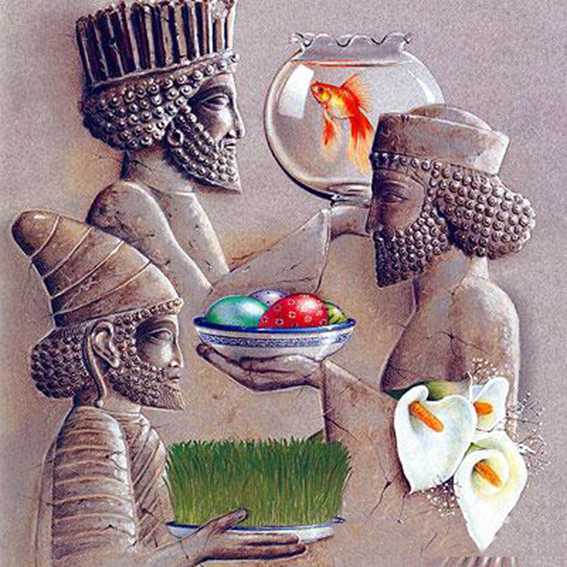
Nowruz is a messenger of peace, friendship, benevolence for the humankind and admiration for the nature not only for Iranians, but for several nations and tribes who adorn this ancient festivity and celebrate it. Nowruz is an opportunity for rethinking, restarting and remaking.
Nowruz is the spiritual heritage of humankind and the Iranians will be most delighted if the world nations enjoy this heritage and take advantage of it. Nowruz is the message of peace and friendship by the Iranians for the whole world.
Nowruz is a strong testimony to Iranian rich civilization, national characteristics and history. It proves how a nation with its irreversible determination to endure, and even flourish, through periods of devastation, political chaos, hardship and oppression.
For centuries, Persians have applied the Nowruz spirit to every dark challenge that has come their way. This spirit has made Nowruz far more than just a New Year celebration over the course of history.
In ancient times the feast started on the first day of Farvardin (March 21) but it is unclear how long it did last. In royal courts, the festivities continued for one month.
The festival, according to some documents, was observed until the fifth of Farvardin, and then the special celebrations followed until the end of the month. Possibly, in the first five days, the festivities were of a public and national nature, while during the rest of the month it assumed a private and royal character.
Undoubtedly, the Nowruz celebrations are an ancient, national Iranian custom, but details of it prior to the Achaemenid era are unknown. There is no mention of it in Avesta - the holy book of Zoroastrians.
In the ancient times, Iran was the cradle of civilizations for thousands of years and regarded as one of the most powerful countries in the world. As time passed, the Empire of Persia disintegrated gradually due to the invasions by the enemies of this land.
As a matter of fact, many glorious cultural, historical, festivals and customs have faded away and only traces of them have remained and several centuries of our homeland history is still in a “state of oblivion, darkness and ambiguity.”
Currently, after several thousands of years, Iranians and the people of nine other countries enthusiastically celebrate the Nowruz festival, irrespective of their age, language, gender, race, nationality or social status as this festivity knows no boundary.
The festival was so glorious and sacred that even the most ruthless rulers used to grant general amnesty to captives and prisoners.
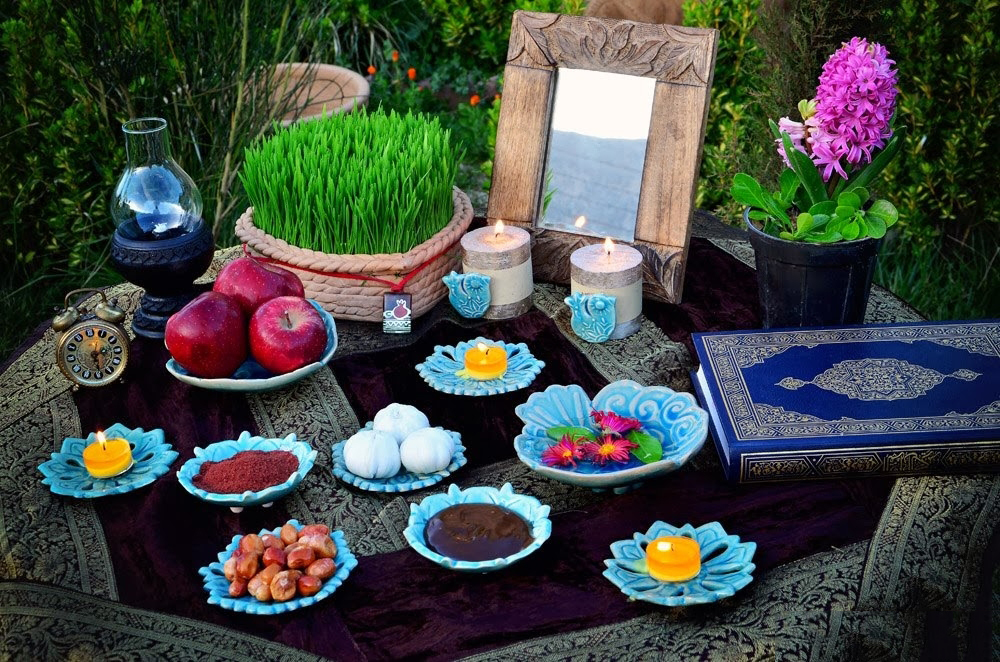
7th sin
A major part of the New Year rituals is setting a special table with seven specific items present, Haft Sin (Haft chin, seven crops before Islam). In the ancient times each of the items corresponded to one of the seven creations and the seven holly immortals protecting them.
Today they are changed and modified but some have kept their symbolism. All the seven items start with the letter S; this was not the order in ancient times. Wheat or barley representing new growth is still present. Fish the most easily obtainable animal and water are present. Lit candles are a symbol of fire. Mirrors are used today, origin unknown.
These were expensive items in ancient times and were made from polished metal. It is unlikely that all households would have one. Zoroastrians today place the lit candle in front of the mirror. Wine was always present. Today it is replaced by vinegar since alcohol is banned in Islam.
Egg a universal symbol of fertility corresponding to the mother earth is still present. Garlic is used to warn off bad omen. Samano a thick brownish paste is present today. It is a nutritious meal and could have been part of the feasts. Coins symbolizing wealth and prosperity, fruits and special meals are present as well.
Ferdowsi the great Iranian epic poet described this auspicious event in Shahnameh
The International Day of Nowruz was registered on the UNESCO List of the Intangible Cultural Heritage of Humanity on February 23, 2010.
Chaharshanbe Suri
Chahārshanbe Suri (Persian: چهارشنبه سوری) is a fire jumping festival, celebrated in Iran.
Loosely translated as Wednesday Light, from the word sur which means light in Persian, or more plausibly, consider sur to be a variant of sorkh (red) and take it to refer either to the fire itself or to the ruddiness (sorkhi), meaning good health or ripeness, supposedly obtained by jumping over it, is an ancient Iranian festival dating back to at least 1700 BCE of the early Zoroastrian era. Also called the Festival of Fire, it is a prelude to Nowruz, which marks the arrival of spring. The words Chahar Shanbeh mean Wednesday and Suri means red. Bonfires are lit to "keep the sun alive" until early morning. The celebration usually starts in the evening, with people making bonfires in the streets and jumping over them singing "zardi-ye man az toh, sorkhi-ye toh az man". The literal translation is, my yellow is yours, and your red is mine. This is a purification rite. Loosely translated, this means you want the fire to take your pallor, sickness, and problems and in turn give you redness, warmth, and energy. There are Zoroastrian religious significance attached to Chahārshanbeh Suri and it serves as a cultural festival for Iranian peoples: Persian Jews, Persian Muslims and Assyrians native to Iran, Persian Armenians, Kurds, Persian Bahai's and Persian Zoroastrians.
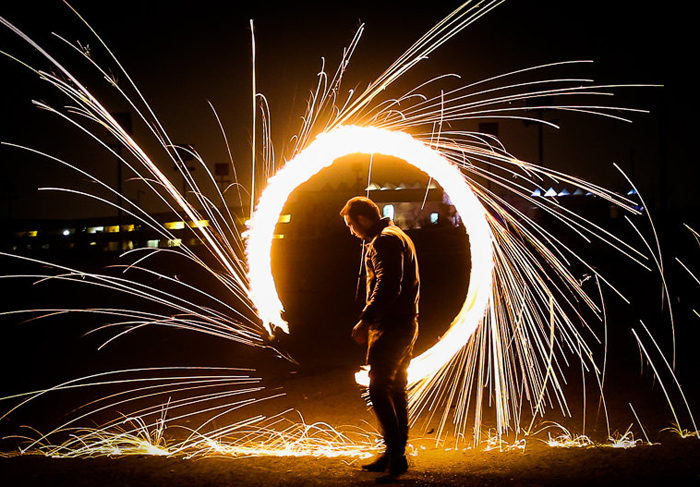
Another tradition of this day is to make special ajeel, or mixed nuts and berries. People wear disguises and go door to door knocking on doors as similar to Trick-or-treating. Receiving of the Ajeel is customary, as is receiving of a bucket of water.
Ancient Persians celebrated the last 5 days of the year in their annual obligation feast of all souls, Hamaspathmaedaya (Farvardigan or popularly Forodigan). They believed Faravahar, the guardian angels for humans and also the spirits of dead would come back for reunion. There are the seven Amesha Spenta, that are represented as the haft-sin (literally, seven S's). These spirits were entertained as honored guests in their old homes, and were bidden a formal ritual farewell at the dawn of the New Year. The festival also coincided with festivals celebrating the creation of fire and humans. In Sassanid period the festival was divided into two distinct pentads, known as the lesser and the greater Pentad, or Panji as it is called today. Gradually the belief developed that the 'Lesser Panji' belonged to the souls of children and those who died without sin, whereas 'Greater Panji' was truly for all souls.
Last Wednesday Eve of the year
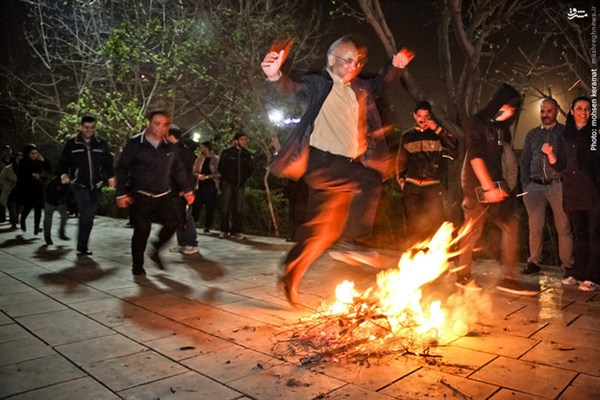
The last Tuesday night of the Iranian year known as Chahar Shanbeh Suri (Chahār shanbé Sūrī – usually pronounced Chārshambé-sūrī), the eve of which is marked by special customs and rituals, most notably jumping over fire. On the eve of last Wednesday of the year (Tuesday night, Wednesday morning), literally the eve of 'Red Wednesday' or the eve of celebration, bonfires are lit in public places with the help of fire and light, it is hoped for enlightenment and happiness throughout the coming year. People leap over the flames, shouting: Sorkhi-ye to az man; Zardi-ye man az to (Give me your beautiful red colour; And take back my sickly pallor)
Ashora
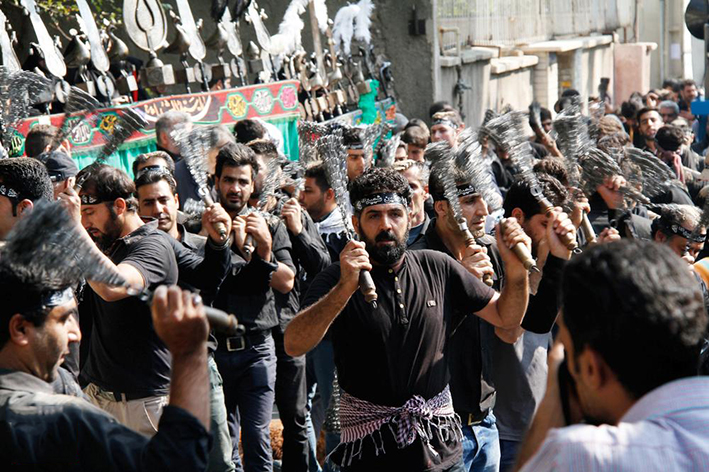
On Friday (23 October), millions of Muslims will gather to mark the holy day of Ashura, the tenth day of Muharram in the Islamic calendar. The 10-day festival of Muharram is observed by both Sunni and Shia sects, but for Shia Muslims it is also a major commemoration of the assassination of Imam Husayn, a Shia leader and the grandson of the Prophet Mohammed.
More about Ashura
· Arbaeen: World's largest annual pilgrimage as millions of Shia Muslims gather in Karbala
· Ashura 2015: Shia Muslims flagellate themselves with swords, chains and knives
· Husayn was killed by the army of the Caliph Yazid at the Battle of Karbala in 680 AD, in what is now modern-day Iraq. His death was an event that led to the split in Islam into two main sects - Sunnis and Shias. During Ashura, some Shia men flagellate themselves with chains, beat their heads and chests with chains and knives, and gash their heads with swords to show their grief and echo the suffering of Husayn in a ritual called "tatbir".
This controversial practice is discouraged by some Shia leaders, who say it creates a negative image - but is still practiced by many. On Ashura, some Shia men and women parade through the streets dressed in black, slapping their chests and chanting, while others reenact the Battle of Karbala with mourning rituals and passion plays. Many also choose the holy day to make a pilgrimage to the Mashhad al-Husayn, the shrine in Karbala in Iraq that is regarded as Husayn's tomb.
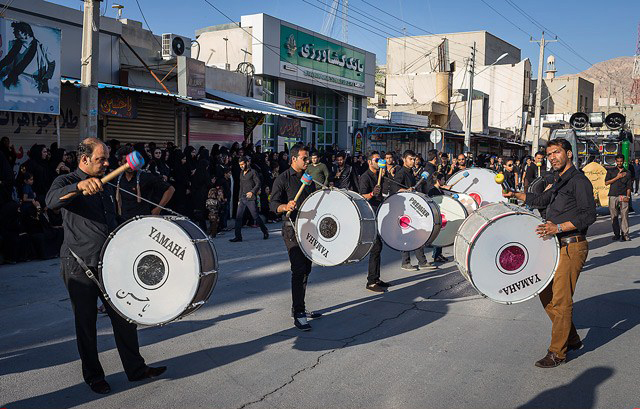
Rose water festival
Every year during the second half of May, festival of Rose and Rose Water is being held in Kashan. Many people from different parts of the country and abroad visit Kashan, the hub of Mohammadi Rose in Iran.The season for picking rose and preparing rosewater is from early May to mid-June.In early May, the scent of rose spreads over different areas of Kashan, such as Qamsar Joshqan Qali, Barzak and Niasar.The ceremony for making rosewater in Kashan attracts many tourists. Every day, some 80,000 people tour various cities of Kashan for this traditional ceremony.The arrival of tourists in the districts of Kashan has a positive impact on the region’s economy.
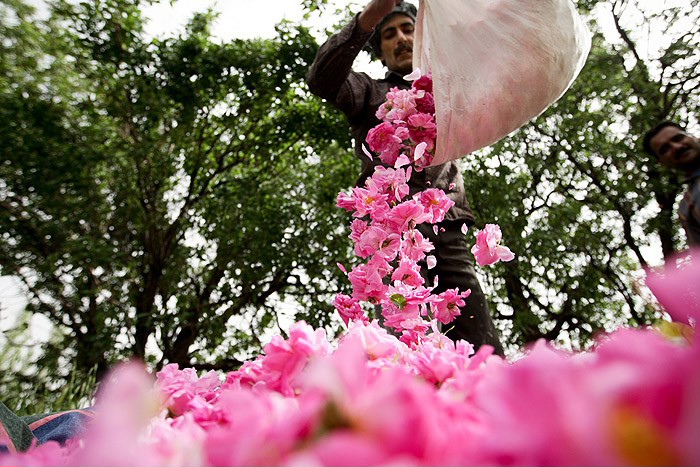
Rose water is made from a very sweet smelling kind of rose and is used in various traditional dishes and sweets. It is also used as a perfume among Muslims. Although some modern mechanized factories are constructed, but still a large part of this, let say industry, is done traditionally. And this traditional rose water production which is established at homes or gardens attracts tourists to Kashan. Historical monuments and architecture of Kashan adds to the popularity of this festival too.
The people of Ghamsar collect roses, boil them in special pots and collect their water in beautiful containers. It is a pride for the city that each year, the most sacred place on earth, Kaaba (Mecca), is washed with rose water from Ghamsar.The ancient city of Ghamsar is like a shining star on the central Iranian desert.Surrounding mountains encircle it like a ring and protect its rose gardens against the heat of the desert. The environment of this garden city, the shade of trees and sound of flowing water in addition to music of birds and nightingales and fragrance of roses, has created an incredible milieu on the side of the desert.
The garden city of Ghamsar is a patch of Paradise which becomes colorful as the spring begins. Its beauty is doubled when rose water ceremony commences and its hospitable people play host to millions of people who love nature and rose water of Ghamsar.
Mohammadi Rose (Rosa damascene or Damask rose) is among the most important roses in the world and among the most famous plants.
Because of its extraordinary fragrance and diversity, this flower is planted in many parts of the world. The flower has applications in food, medicine and perfume industries.Production of rosewater in Iran dates back to over 2,500 years. At present, Mohammadi Rose is produced in Bulgaria, Turkey, Iran, India, Ukraine, the US, Canada, France, Britain and Japan. The first four countries are pioneers in the production of this flower.
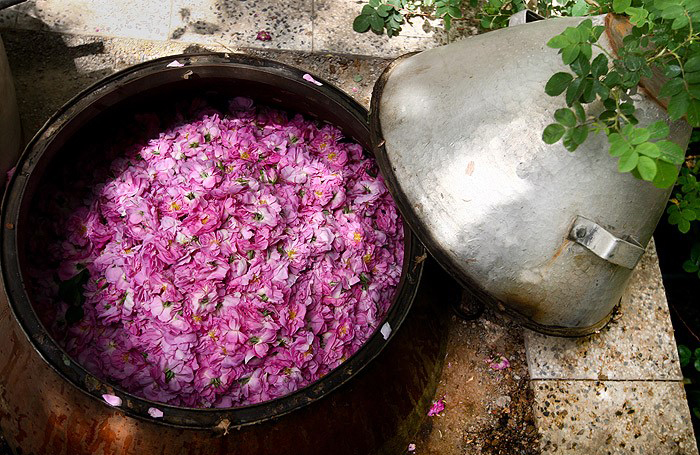
In Iran, Mohammadi Rose grows in the provinces of Fars, Kerman, Isfahan as well as East and West Azarbaijan.The red rose, or Mohammadi rose, is further divided into seven groups: French red flower, wild rose, tea flower, miniature red flower, Bengalese red flower, and Iranian red flower.
Out of all rose species, the Iranian red flower or Mohammadi flower is unique and most botanists have opined that it has been first planted in Iran and then taken to other countries.
Experts maintain that Ghamsar has been a place for producing flower and rose water since a long time ago. Some believe that under Malekshah the Seljuk, when Miyandeh Mosque of Ghamsar was built, representative of an East Roman officials picked some roses from the slopes of Kouh Asbi mountain near Ghamsar and took them to Damascus (which was called Damask in those times) to be grown. This is why Iranian red flower is sometimes called Damask rose in English.
Although production of plant essences has a long history in Iran, but traditional rose water production machines were used to produce rose water for commercial purposes. Before that, rose water was produced through small distillation equipment for local uses. Anyway, production of rose water has been in vogue since ancient time and has sometimes led to prosperity of copper, glass making and packaging industries. Most of the local product is exported to other parts of the country and, therefore, despite most handicrafts, it has held its ground in contemporary times and has constantly improved in terms of quality and quantity.Another outcome of that situation was spread of the industry to neighboring villages of Ghamsar and even to other provinces during past decades. The emphasis put on Ghamsar is due to high quality of its rose water which results from natural conditions of the city.The city has been and still is the main production center for the highest quality rose water as a result of its natural and climatic conditions. According to a study carried out by professors of Tehran University, the essence of Mohammadi flower of Ghamsar and the subsequent rose water has a concentration of 35 mg per 100 ml or 350 ppm, which makes it the finest and highest quality rose water in Iran and even in the world.
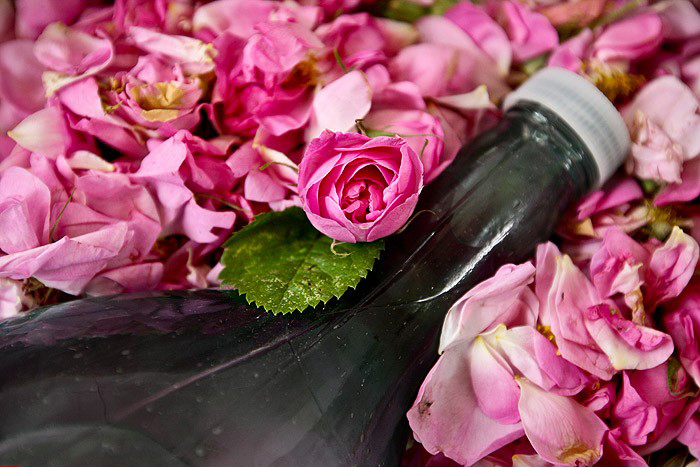
Equipment used for extraction of rose water in Ghamsar is nearly traditional and has hardly changed over the years. They include:
1. A copper pot with a capacity of 120-150 liters;
2. A big clay pot, which has not been replaced by the copper pot and is used to cover the pot. A major advantage of clay pot was that it did not burn the fragrance of the flower;
3. A copper pitcher with handle and a capacity of about 30-40 liters which is put in cold water, so that flower streams are turned into liquid;
4. Four wooden canes which are attached to each other to connect the pot to the pitcher; today, they use aluminum pipes instead of those canes;
5. A water pool where liquefaction is done; and
6. Heating equipment under the copper pot which is usually fed by oil or diesel fuel. In the past they used wood and bushes to warm it up.
First the copper pot is put on an oven made from bricks and cement or stones and mud. The heating agent is put below it. Then up to 30 kg of rose petals are poured into the pot and 80 liters of water is added. The pot is then covered and a heavy weight is put over it to control steam pressure. Probable holes and cracks are covered with a mortar made of the remnants of boil flowers and bread dough to prevent loss of steam.
Instead of weight and dough, they use elastic washers, screws and levers. The copper pitcher is put into the water and is kept in place by a ladder, or more recently, by cast iron pipes, so that, it will not rise to the surface of the water. Then canes or aluminum pipes are inserted into the pot, on the one side, and into the pitcher, on the other side and they wrap it in a piece of fabric with a cotton ball, so that, water would not penetrate into the pitcher. Water or any other foreign object will ruin the rose water.
Now, everything is ready. They kindle the oven to boil the pot. At that time, rose water and water steam progress in the pipe as far as the angle. From there, rose water steam continues toward the pitcher and is liquidated due to low temperature of environment. It takes about 4 hours before a pitcher full of rose water (40 liters) is obtained. When they pour the rose water into the bottle, they wait for it to cool down.
Then they rub some oil on the bottle. The waste collected at the bottom of the pot, which is called “bongol”, is used to feed livestock and is also dried to be used as fuel in winter or as fertilizer for gardens.During the whole process, the flame should be steady and mild. In better words, the longer the distillation period and the steadier the flame, the higher would be quality of the end product. The water poured into the pot should be measured accurately to be proportionate to the weight of flower petals.
Ghamsar is the breeding ground for the finest and the most exquisite Mohammadi flowers and has the best traditions and methods for production of rose water. It is also the first place where industrial production of rose water has begun and there are many workshops in the city which produce rose water.
The first rose water production plant in Iran was established in Ghamsar in 1974-75 after studies were conducted by Bulgarian experts. It was built on the outskirts of Ghamsar (at 15th kilometer of Ghamsar – Kashan road). The second rose water production plant was established at the entrance of Ghamsar city and is called Golriz. The cooperative company of rose water producers of Ghamsar has established a plant at industrial park of Ghamsar in order to solve the problem of pasteurizing traditional rose water, which was the main hurdle on the way of production and sales of rose water. Behin Golab Company of Ghamsar is another example of industrial rose water production plants in the city and more plants will be launched soon.
Due to containing tannin, gallic acid, essence, fatty acids, pigments and ascorbic acid (vitamin C), petals of Mohammadi flower are used not only for production of rose water and essence, but for production of rose petal jam.
Since a long time ago, this plant was used in traditional medicine to treat various diseases including chronic diarrhea, rheumatic pains, blood abnormalities, and sore throat.
The part of the flower, which is used to produce rose water and essence, is petals. Boiled petals of Mohammadi flower are alkaline and constitute a good remedy for stress, flatulence, and abdominal colic. The boiled petals are also used to fight depression and to treat palpitation, insomnia, ordinary and bloody diarrhea, sickness, and inflammation.
In the past, rose water was used in traditional Iranian medicine to treat rheumatic heart disease, to strengthen gastric nerves, and to treat some forms of headache and sickness.